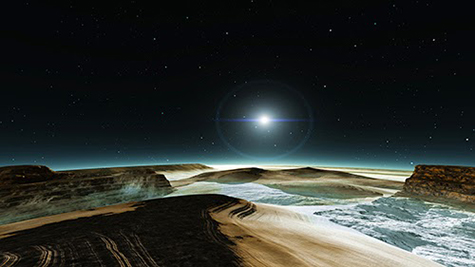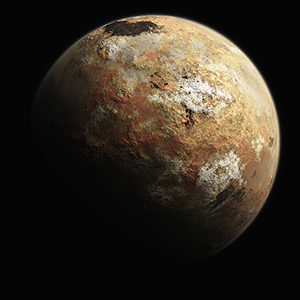
After an epic journey across the breadth of the solar system, NASA’s New Horizons spacecraft is finally nearing its destination: the Pluto system, a staggering 3 billion miles from Earth. In December, after a journey of nine years, the spacecraft was brought out of hibernation for the last time in preparation for its rendezvous with the dwarf planet the week of July 12.
Asked if he is excited, William McKinnon, PhD, a planetary scientist in Arts & Sciences at Washington University in St. Louis who is a co-investigator on the science team of New Horizons, said, “How can I answer that question? We’ve been trying to do this for 25 years, and now it’s all of a sudden happening. It kind of seems a little unreal. Like, is this really happening?”
The last such “first encounter” with a planet was in 1989, when Voyager 2 took a look at Neptune on its way out of the solar system. Half the people in the United States are too young to remember that flyby.
“Old-timers like me remember these first encounters and how fascinating they were,” McKinnon said. “I can remember looking at the newspaper as a boy on the floor of my parents’ living room at the first pictures of Mars sent from Mariner 4, which were grainy and showed craters.
“Something of a disappointment; nobody waving,” he said, with characteristic deadpan humor.
“But all of the first encounters with the giant planets and their satellites were really fascinating,” he said. “The sheer strangeness of these places, which became real worlds once we could see them, was fascinating to me. So this first encounter will be fun.”
But a first encounter with what?
When New Horizons was launched, Pluto was called a planet and Charon was Pluto’s only known moon. In 2006, Pluto was reclassified as a dwarf planet, and the Hubble Telescope has since found four more moons orbiting Pluto: Nix, Hydra, Kerberos and Styx.
What happened?
“In the 1980s, light-sensitive, charge-coupled detectors (CCDs) came over from the military and they could see much fainter objects than chemically sensitized photographic plates,” McKinnon said. In 1992, using a CCD attached to a telescope, astronomers David Jewitt and Jane Luu discovered the first Kuiper Belt object. Six months later they found another one. “Then everyone ran to the telescope,” McKinnon said.

Today there are more than 2,000 catalogued bodies in the Kuiper Belt, including several that qualify as dwarf planets. “That’s enough that we can see the structure of the belt,” McKinnon said. “And the best — maybe the only — way to explain that structure is to revise our notion of how the planets coalesced and settled into their orbits.
“We were all taught, or assumed for simplicity, that the giant planets in the outer solar system formed more or less where they are and sat there for the rest of time,” McKinnon said. “But people who made models of the gas giants forming couldn’t make them sit still because there’s too much exchange of energy and momentum among them and smaller bodies.”
In 2005, an international group of astronomers working in Nice, France, proposed that the giant planets originally formed much closer to Jupiter, the gas giant closest to the sun, but then moved outward, eventually hitting a mutual gravitational sweet spot that sent Neptune rocketing into the belt of planetesimals (bits and pieces of planetary stuff) that ringed the solar system.

The errant Neptune threw the belt into chaos. It locked some of the bodies into orbital resonances with itself and, with the aid of the other giant planets, hurled most of them out of the solar system, or caused them to collide with one another or one of the planets, including Earth. When the dust settled, the orbital resonances formed the inner and outer boundaries of a depopulated belt of stable orbits.
“Today when you make detailed computer models of the solar system’s formation,” McKinnon said, “you get something that actually looks like the Kuiper Belt today.”
So our understanding of Pluto has been completely revised while New Horizons has been speeding toward its rendezvous. The ninth planet by 20th-century reckoning has become the first of a new, third class of planets in the 21st century, transforming our understanding of how the solar system formed. Big deeds for a small planet.